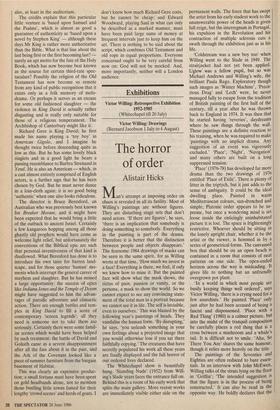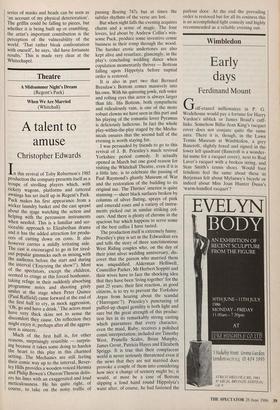Exhibitions
Victor Willing: Retrospective Exhibition 1952-1985 (Whitechapel till 20 July)
The horror of order
Alistair Hicks
an's attempt at imposing order on chaos is revealed in all its futility. Most of Willing's paintings are without figures. They are disturbing stage sets that don't need actors. 'If there are figures', he says, `there is an implication that somebody is doing something to somebody. Everything in the painting is part of the drama. Therefore it is better that the distinction between people and objects disappears.' The fearsome 1984 drawings of masks can be seen in the same spirit, for as Willing wrote at that time, 'How much we invest in a face! Everything is there, we feel, if only we knew how to mine it. But the painted face will show what the mask shows, the rictus of pain, passion or vanity, or the persona, a mask to show the world. So we cannot expect to see any convincing state- ment of the total man in a portrait because we cannot see it in life. The self is invisible, even to ourselves.' This was blasted by the following year's paintings of heads. They vandalise the human form. 'By disrupting,' he says, 'you unleash something in your own feelings about a projected image that you would otherwise lose if you sat there faithfully copying.' The creatures that have secretly populated his work all these years are finally displayed and the full horror of our ordered lives declared.
The Whitechapel show is beautifully hung. 'Standing Nude' (1952) from Will- ing's Slade years faces the entrance full on. Behind this is a room of his early work that splits the main gallery. More recent works are immediately visible either side on the permanent walls. The force that has swept the artist from his early student work to the unanswerable power of the heads is given full reign, but the interregnum in Portugal, his expulsion in the Revolution and his contraction of multiple sclerosis cuts a swath through the exhibition just as in his life.
`Coldstream was a new boy too' when Willing went to the Slade in 1949. The straitjacket had not yet been applied. Uglow' was a fellow pupil, but so was Michael Andrews and Willing's wife, the brilliant Paula Rego. Exploratory though such images as 'Winter Machine', 'Preca- rious Drag' and 'Lech' were, he never managed fully to escape from the tradition of British painting of the first half of the century, till a year after he was thrown back to England in 1974. It was then that he started having 'reveries', daydreams where he saw things through the wall. These paintings are a definite reaction to his training, when he was required to make `paintings with no implicit drama. Any suggestion of an event was vigorously excluded."Place', 'Night', 'Navigation' and many others are built on a long suppressed tension.
`Place' (1976-78) has developed far more drama than the two drawings of 1976 entitled 'Place of Exile'. There is plenty of litter in the triptych, but it just adds to the sense of ambiguity. It could be the ideal dwelling place. Painted in warm Mediterranean colours, sun-drenched and simple; Platonic order appears to be su- preme, but once a wondering mind is set loose inside the enticingly uninhabitated picture it is lost. The space is frighteningly restrictive. Whoever should be sitting in the lonely upright chair, whether it be the artist or the viewer, is hemmed in by a series of geometrical forms. The canvassed box that should be on an open beach is contained in a room that consists of neat patterns on one side. The open-ended horizon across the way is misleading. It gives life to nothing but an unfriendly overgrown pot plant.
`In a world in which most people are busily keeping things well ordered', says Victor Willing, 'there is a crying need for a few anarchists.' He painted 'Place' only just after he had been accused of being a fascist and dispossessed. 'Place with a Red Thing' (1980) is a calmer picture, but into the midst of the tranquil composition he carefully places a red thing that is a cross between a mushroom and a whale's tail. It is difficult not to smile. `Aha, So There You Are' shares the same humour, though it relies more heavily on the title. The paintings of the Seventies and Eighties are often reduced to bare essen- tials. In an interview with John McEwen, Willing talks of the struts lying on the floor in 'Griffin% 'The intended suggestion is that the figure is in the process of being constructed.' It can also be read in the opposite way. He boldly declares that the series of masks and heads can be seen as `an account of my physical deterioration'. The griffin could be falling to pieces, but whether it is being built up or crumbling, the artist's important contribution is the perception of the vulnerability of the world. 'That rather bleak confrontation with oneself , he says, 'did have fortunate results.' This is made very clear at the Whitechapel.



















































 Previous page
Previous page